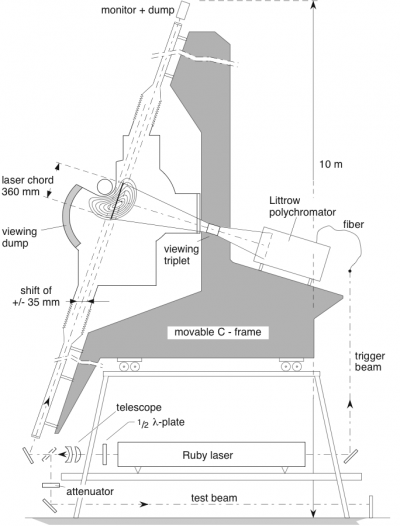TJ-II:Thomson Scattering
The high-resolution Thomson Scattering system (located in sector D2, φ = 14.5°) provides electron temperature, density, and pressure profiles at a single time in the discharge. [1] [2] [3] [4] [5] [6] The laser chord is inclined by 17° from the vertical.

For reliable operation of the diagnostic, the parameters of the plasma should lie in the design range. E.g., very low density plasmas are unsuitable due to very low signal, intrinsic system noise, and stray light contamination, and very low temperature plasmas due to scattered spectra that lie mainly within the notch filter attenuation band.
Calibration
Wavelength calibration: The spectrometer is illuminated with light coming from Helium and Argon spectral lamps, both having well documented, intense lines in the range from 550 to 850 nm.
Position calibration: A set of ∼ 20 carefully aligned pinholes, (diameter 300 microns, separation 20 mm), illuminated by a tungsten lamp, are imaged onto the spectrometer, to provide position calibration along the laser chord. In order to obtain the effective radius, the precise location of the laser chord and optical axis of the spectrometer with respect to TJII must be known. This measurement was performed when the system was first installed.
Relative calibration: This procedure is used to calibrate the relative response of the spectrometer as a function of wavelength and position. A tungsten-halogen lamp with a known, broad spectrum (black-body like) is used to this effect. The current in the lamp is kept constant by using a regulated power supply.
Absolute calibration: in order to provide absolute density calibration, Rayleigh scattering with N2, CO2 or other gases has been used. This method is hard to implement in TJII due to the large amount of stray light entering the spectrometer that makes the evaluation of Rayleigh scattering signal from the gas problematic. Other techniques, like evaluation of the absolute density factor in profiles at or near to an ECRH cut-off have been tried. Regular comparisons with data from the interferometer can be used as a method to get the absolute density factor on profiles. The shape of the ne profile is nevertheless robust, since it depends only on the relative calibration.
Data description
The number of data points along the chord can vary from shot to shot depending on magnetic configuration, the shape of actual plasma, the influence of stray light level on data quality, etc; typically, it is of the order of 200. The estimated spatial resolution of diagnostic is approximately 2.4 mm. Due to a delay between the software trigger and the firing of the laser, the Thomson Scattering measurement occurs 6.4 ms after the trigger time stored in the database. Signal names in the TJ-II database: 'PerfilRho_', 'PerfilTe_', 'PerfildTe_', 'PerfilNe_', 'PerfildNe_', 'PerfilPe_', 'PerfildPe_'.
References
- ↑ C.J. Barth et al, High-resolution multiposition Thomson scattering for the TJ-II stellarator, Rev. Sci. Instruments, Vol. 70, 1 (1999) 763-767
- ↑ J. Herranz, I. Pastor, F. Castejón, E. de la Luna, I. García-cortés, C.J. Barth, E. Ascasíbar, J. Sánchez, and V. Tribaldos, Profile structures of TJ-II stellarator plamsas, Phys. Rev. Lett. 85 (2000) 4715
- ↑ C.J. Barth et al, Calibration procedure and data processing for a TV Thomson scattering system, Rev. Sci. Instruments, Vol. 72, 9 (2001) 3514-3527
- ↑ J. Herranz et al. Analysis of the Detection Process and Error Sources for the Thomson Scattering Profile Measurement in TJ-II. Proc. issues of the 14th Topical Conf. on High Temperature Plasma Diagnostics, A.P.S., July 8, 2002, Madison, WI
- ↑ J. Herranz et al, The spectrometer of the high-resolution multiposition Thomson scattering diagnostic for TJ-II, Fus. Eng. And Design, 65 (2003) 525-536
- ↑ B.Ph. van Milligen et al, Revision of TV Thomson scattering data analysis and detection of profile structure, Rev. Sci. Instrum. 74 (2003) 3998